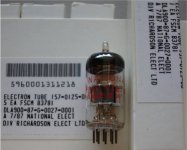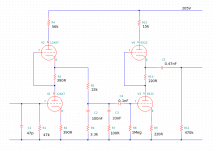I'm building phono amp. I want to use 6922 tubes in second stage and the tubes I have are made in Japan by National Elecric. On box says:
157-0125-00
date is 7/87
Does anybody know if those are a 6922 type tubes and if not what they are?
157-0125-00
date is 7/87
Does anybody know if those are a 6922 type tubes and if not what they are?
I don't know what You mean by visual input error 4562. I'm kind of new here. I need to add that tube has shield between sections.
Thank You for replay. I have picture but I don't know how to post it here. It appears that my computer doesn't want to cooperate. I try it again.I think he means post a picture of the tubes in question. As number 5 would say. "More input". 😀
[image][/image]
Attachments
What is the pinout of the tube?
If it is the same as the 6922, it may be a 6DJ8 or a 6922.
The 6DJ8 tends to have more noise than the 6922.
It may work okay in the second stage.
If it is the same as the 6922, it may be a 6DJ8 or a 6922.
The 6DJ8 tends to have more noise than the 6922.
It may work okay in the second stage.
As far as I can tell by looking at the tube the pin #1 & 6 are anodes and #9 is internal shield. So it may be 6922 or 6DJ8. Part number 157-0125-00 may be Tektronix part number, I don't know for sure, and they used 6922 and 6DJ8 tubes in their scopes. If my tubes are industrial versions, I wander how good are they for audio applications.
According to that Tubes inconnus,,,besoin d'aide - Général Haute-Fidélité and knowledge of french language from school (It was living hell  ), these tubes really seem to be authentic 6DJ8/6922/ECC88. Your picture supports that opinion, too. They were rebranded by National (=Richardson) for a very special purpose. Where did you got them ?
), these tubes really seem to be authentic 6DJ8/6922/ECC88. Your picture supports that opinion, too. They were rebranded by National (=Richardson) for a very special purpose. Where did you got them ?
 ), these tubes really seem to be authentic 6DJ8/6922/ECC88. Your picture supports that opinion, too. They were rebranded by National (=Richardson) for a very special purpose. Where did you got them ?
), these tubes really seem to be authentic 6DJ8/6922/ECC88. Your picture supports that opinion, too. They were rebranded by National (=Richardson) for a very special purpose. Where did you got them ?Something very strange is going on here.
The 5960... number below the bar code is a National Stock Number
Starting with 5960 it indicates an electronic tube (Surprise! 🙂 )
The number is normally viewed in this format: 5960-00-131-1218
Checking it out it certainly references to Tektronix and to one of their partno's: 157-0125-00
Just one glitch: That appears to be a Cathode Ray Tube
FYI the NSN x-ref's to an older number: 5960-00-245-6551 but that's not likely to do you much good.
rgds,
/tri-comp
The 5960... number below the bar code is a National Stock Number
Starting with 5960 it indicates an electronic tube (Surprise! 🙂 )
The number is normally viewed in this format: 5960-00-131-1218
Checking it out it certainly references to Tektronix and to one of their partno's: 157-0125-00
Just one glitch: That appears to be a Cathode Ray Tube
FYI the NSN x-ref's to an older number: 5960-00-245-6551 but that's not likely to do you much good.
rgds,
/tri-comp
Thank You for quick reply. Now I'm going ahead with my project. As to the tubes, I got them from Richardson Elect. LTD some years ago for the power amp, the same amp. my cat is warming up in. They were cheap so I got ten of them. I couldn't get any datasheets for them so I end up using 12EU7's. Now I want to bring them back to life again. Thank You again.According to that Tubes inconnus,,,besoin d'aide - Général Haute-Fidélité and knowledge of french language from school (It was living hell), these tubes really seem to be authentic 6DJ8/6922/ECC88. Your picture supports that opinion, too. They were rebranded by National (=Richardson) for a very special purpose. Where did you got them ?
I bought those tubes because they were cheap. I got second thoughts after I could not find cross reference data. Now I want to give them second chance. I still think there is something strange about those tubes, but I'm going ahead with my project. I don't care if they are not NOS Mullard or Telefunken.
Great cat!!
They seem to be from an auction and indeed 6DJ8/ECC88
All-in-One Report for National Stock Number: 5960001311218, Part Number: 157012500 - PartsLogistics
So I'd go for it!
They seem to be from an auction and indeed 6DJ8/ECC88
All-in-One Report for National Stock Number: 5960001311218, Part Number: 157012500 - PartsLogistics
So I'd go for it!
Great cat!!
They seem to be from an auction and indeed 6DJ8/ECC88
All-in-One Report for National Stock Number: 5960001311218, Part Number: 157012500 - PartsLogistics
So I'd go for it!
Thank You for helping me out. I'm going ahead with it. My old tube phono amp is very cheap and lousy, but sounds whole lot better than any solid state amps I had. Now I can upgrade it. Thanks again.
P.S.
As to the cat, I don't know how she stand it. Those EL34's are getting pretty damn hot.
If you want to stack tubes like that, pay much attention to the heater supply- it will need to be biased positively in order to not exceed heater-to-cathode voltage limits.
I haven't run the numbers, but I'd wild-***-guess that the gain will be too low and the distortion will be too high. It will not follow RIAA very well. I have no idea what the function of the plate resistors is.
Have you read carefully the section on phono stage design in Morgan Jones's "Valve Amplifiers"? If not, I strongly recommend it.
I haven't run the numbers, but I'd wild-***-guess that the gain will be too low and the distortion will be too high. It will not follow RIAA very well. I have no idea what the function of the plate resistors is.
Have you read carefully the section on phono stage design in Morgan Jones's "Valve Amplifiers"? If not, I strongly recommend it.
or have idea to improve it, please, let me know.
12AX7 lends 5.63 nVrtHz of noise, R2 further lends 2.5nVrtHz of noise to your input stage. To picture it, a 5534 OPAMP has 3.5nVrtHz @ 1kHz spec. If its for an MM level cart, try to keep it 40dB gain max, maybe by a second stage tube of less mu so the total gain will not be excessive, thus to end up with no stronger presence of hiss than strictly necessary at the output.
P.S. Allocate as much gain and linearity as possible to the first stage.
I would remove the anode resistors. 12AX7 is a guitar tube for those preferring soft tubey sound. I prefer 6DJ8/E88CC overall. Put a 100R resistor at the grids directly on the socket for preventing oscillation. I have a similar phono preamp, but 3 stages (the passive eq is splitted).Now I have almost finished diagram. It is mostly guess work. If anybody see mistakes or have idea to improve it, please, let me know. Preferably before I put it together.
- Status
- Not open for further replies.
- Home
- Amplifiers
- Tubes / Valves
- 6dj8 phono amp


